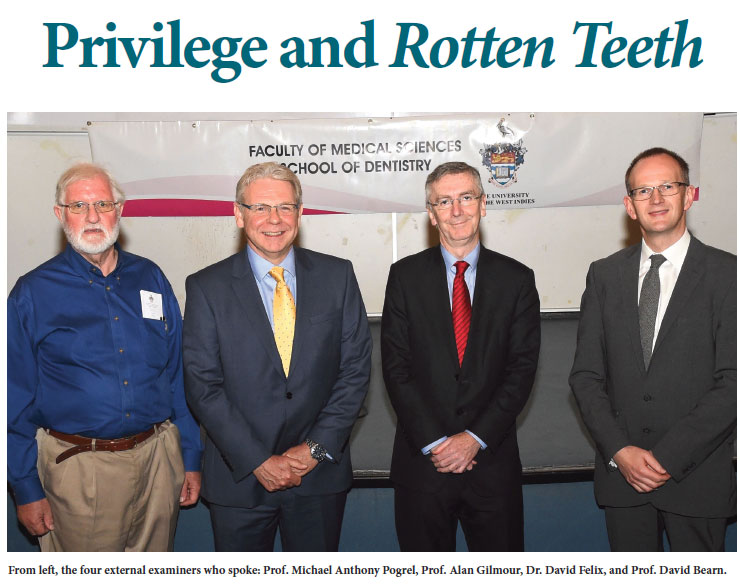 |
 |
 |
|
July 2016 |
It’s not an obvious connection; that’s why these kinds of information are unearthed by research. In this case, some dental research discussed at a lecture series hosted by The UWI School of Dentistry in May offered some interesting historical connections among sugar, money and rotted teeth. “For instance, the rotted teeth of characters in ‘Pirates of the Caribbean’ would be most likely to occur in wealthy people who could afford sugar and not in poorer people as portrayed. The common practice of wealthy people buying or taking healthy teeth from poorer people for transplantation into their own mouths continued until the mid-1800s when it was realised that other diseases were transplanted as well,” says Professor Montgomery McAulay-Rieger, the Dentistry School’s Director. Professor McAulay-Rieger was adding to information provided by Professor Michael Anthony Pogrel, who spoke on “Stents” and how it was originally the name of a dental impression material, and of Dr. Charles Stent, the man whose surname now covers many different medical devices. Prof. Pogrel, Head of the Department of Oral and Maxillofacial Surgery at the University of California San Francisco, also provided data to show that dental caries was negligible worldwide until the introduction of sugarcane agribusiness in Jamaica by the British. He summarized his talk for UWI TODAY. “The basic story is that from the early years from the 19th century, it was necessary to be able to do dental impressions in order to make reasonably well-fitting false teeth. The reason for this is that dental decay and gum disease had arrived in Europe. It had been known previously but was actually very rare. The reason it became almost epidemic from the late 1700s is coupled to the arrival of sugar. “Sugar cane is native to Southeast Asia. It was probably brought back to Europe and the Middle East by Marco Polo, and sugar was certainly known to the Crusaders in the 11th and 12th centuries, but was really unobtainable in Western Europe. Most sweetening was done by the use of honey which was both rare and relatively expensive. Therefore, most foodstuffs were unsweetened. The big change came when Britain captured Jamaica from the Spanish in 1665 and managed to grow sugar quite successfully. “Attempts had been made to introduce sugarcane to the New World prior to this. The Portuguese had tried to grow it in Brazil but not terribly successfully, and the Dutch had also tried. It is probably from these people that the British obtained their first sugarcane to plant in Jamaica. The sugarcane actually thrived in Jamaica and later began to be exported back to Britain. As you may know, the growing and harvesting of sugarcane is very labour intensive, and indirectly, this led to the introduction of slavery in the Caribbean. By 1770, the cost of sugar in Britain had plummeted and everybody could buy as much of it as they wanted. This directly fueled the upsurge in dental caries in Britain and the rest of Europe, and the loss of teeth necessitating dental impressions with Dr. Stent’s impression material and the manufacture of false teeth. “The main problem was actually making realistic-looking false teeth, and attempts were made to carve them from walrus tusks and even from wood. The situation was saved by the Battle of Waterloo where 51,000 relatively fit and healthy people died in a relatively small area of Belgium. The teeth were collected from the dead bodies and shipped back to Britain in barrels to be used for false teeth that were actually called Waterloo Teeth. They did look realistic, but unfortunately, were as prone to decay as the original teeth. By about 1820 (the Battle of Waterloo was in 1815), the supply of Waterloo Teeth was exhausted, and that is when Claudia Ash came up with the first porcelain teeth.” This was just one of the fascinating topics covered at the External Examiners Lecture Series hosted by the School of Dentistry. Prof. Alan Gilmour, Associate Dean of Undergraduate Studies (BDS) Cardiff University, presented “The Dental Graduate: Independent Practitioner or Safe Beginner.” Dr. David Felix, Postgraduate Dental Dean, NHS Education for Scotland, presented “Prescribing Update.” Prof. David Bearn, Professor of Orthodontics and Associate Dean for Learning and Teaching, University of Dundee Dental School, presented “Interceptive Orthodontics – An Evidence-based Update.” |

